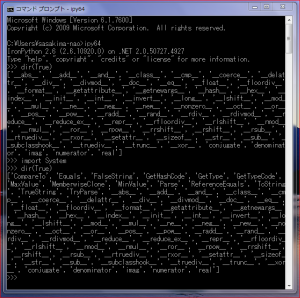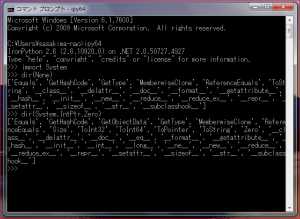今日の覚書ページ追加。
かなり強引なコードになってしまったが…
gtk.Button
覚書ページに gtk.Button を追加。
gtk.Button だけでは書くことがスゲェ少ないのでオマケ付き。
細かい解説ではなく実用的に書いているつもり。
というか解説ならば英語だけど公式サイトのみで十分だと思うのよね。
しばらくは覚書ページに専念…するかもしれない。
アルゴリズム関係の勉強もやりたいし自作アプリの機能追加もやりたいし…
gtk.Label
我ながら超久々に PyGtk の覚書ページを追加した。
書き換え以外で調べたら半年ぶりだった、反省。
あそこに書いた方法では現行 GTK+ で動画再生はもうできないことについては
ページをどんどん追加して違った角度で書き換えしようという結論にした。
ま、Y901x の Python コードを見れば解るはずだが。
あんまり需要無いけど、C 関連のほうがアクセス多いし。
人生を書き換える者すらいた。: 人材獲得作戦・4 試験問題ほか
ネットをうろうろしてこんな所を見つけたけど私にはまったくできなかった。
というよりまず端末に迷路を表示する方法から解らない。
え!だろうけど事実だ、GUI のノウハウは腐るほどあるけど CUI とアルゴリズムはまるでダメ。
好きなことだけ勉強する独学の恐ろしさを思い知る、いったい私は十年間何をやってきたのだ…
PythonでA*(A-Star)アルゴリズム – Pashango’s Blog
その手の学校に行った人ならこんなアルゴリズムなんて常識なんだろうな。
何を今頃アルゴリズムというものをキチンと勉強しなければという気になった。
勉強だけじゃツマランから GUI についてはもっと追記しよう。
Python IniFile Read and Write
前々回 Python の True, False は整数と書いたけど
そういえば isinstance() は?
やっぱりそうなるか。
他にオブジェクトのタイプを正確に調べるには…
How to compare type of an object in Python? – Stack Overflow
こんなに色々タイプ比較方法があったんだ、めもめも。
でも速度はどうなるんだろう?
import time
t = 100000
s0 = time.time()
for i in range(t):
isinstance(i, int)
print time.time() - s0
s1 = time.time()
for i in range(t):
type(i) is int
print time.time() - s1
s2 = time.time()
for i in range(t):
"%d" % i
print time.time() - s2
結果
0.0666399002075 0.0661001205444 0.157742977142
変わらないや、一応試した文字列変換可能かどうかでは遅すぎるかやはり。
私が以前自分で書いたコレもサル丸出しだなと。
とにかく type() がいいみたいなので現行版をベースに作りかえてみる。
とはいえもはや SeeMe で使っているのは原型を留めていないのであるが…
ついでにアトリビュートには直接アクセスできないようにとか % 演算子に変更とか…
#!/usr/bin/env python
#-*- coding:utf-8 -*-
ERROR_READ = 'Configuration file READ ERROR\n[%s]\n%s=\nvalue is not %s'
ERROR_WRITE = 'Configuration file WRITE ERROR\n(%s, %s) value is not %s'
ERROR_HEADER = 'Configuration file header value is not str'
import os
class InifileBase():
"""
This class is Inheritance Base
"""
def __init__(self, filename):
"""
Attribute is the file name only
"""
self._filename = filename
def _get_value(self, section, key):
"""
This Methods is Inheritance Base
"""
return None
def read_int(self, section, key, default):
"""
@param default: int.
"""
result = self._get_value(section, key)
if result == None:
return default
try:
return int(result)
except:
raise ValueError, ERROR_READ % (section, key, "int")
def read_float(self, section, key, default):
"""
@param default: float.
"""
result = self._get_value(section, key)
if result == None:
return default
try:
return float(result)
except:
raise ValueError, ERROR_READ % (section, key, "float")
def read_bool(self, section, key, default):
"""
@param default: bool.
"""
result = self._get_value(section, key)
if result == None:
return default
if result == "1" or result == "-1":
return True
elif result == "0":
return False
else:
raise ValueError, ERROR_READ % (section, key, "bool")
def read_str(self, section, key, default):
"""
@param default: str.
"""
result = self._get_value(section, key)
if result == None:
return default
return result
class InifileReader(InifileBase):
"""
This class is read-only
ini files to load faster
"""
def __init__(self, filename):
"""
@param filename: the full path name.
"""
InifileBase.__init__(self, filename)
def _get_value(self, section, key):
"""
Read using the file stream
"""
if os.path.exists(self._filename):
section_in = False
f = open(self._filename)
try:
for linenn in f:
line = linenn.strip()
if line == "":
continue
if section_in:
if "=" in line:
pos = line.index("=")
if key == line[:pos]:
return line[pos+1:]
if len(line) > 2 and line[0] =="[" and line[-1] == "]":
return None
if len(line) > 2 and line[0] =="[" and line[-1] == "]":
if section == line[1:-1]:
section_in = True
finally:
f.close()
return None
class Inifile(InifileBase):
"""
ini file to read and write class.
"""
def __init__(self, filename):
"""
Loading degradation inifile
@param filename: the full path name.
"""
InifileBase.__init__(self, filename)
self._header = ""
self._ini = []
if os.path.exists(filename):
f = open(filename)
x = f.read()
f.close()
lines = x.split("\n")
section = ""
for line in lines:
if line == "":
continue
if len(line) > 2 and line[0] =="[" and line[-1] == "]":
section = line[1:-1]
elif section == "":
pass # Nothing
elif "=" in line:
pos = line.index("=")
self._add(section, line[:pos], line[pos+1:])
def _add(self, section, key, value):
"""
Add to contents.
"""
for dic1 in self._ini:
if section in dic1.keys():
for dic2 in dic1[section]:
if key in dic2.keys():
dic2[key] = value
return
dic1[section].append({key: value})
return
self._ini.append({section: [{key: value}]})
def _get_value(self, section, key):
"""
Get to contents.
"""
for dic1 in self._ini:
if section in dic1.keys():
for dic2 in dic1[section]:
if key in dic2.keys():
return dic2[key]
return None
def save(self):
"""
Save the contents.
"""
s = ""
if self._header:
s += self._header
for dic1 in self._ini:
for section in dic1.keys():
s += "[%s]\n" % section
for dic2 in dic1[section]:
for key in dic2.keys():
s += "%s=%s\n" % (key, dic2[key])
s += "\n"
if s != "":
f = open(self._filename, "w")
f.write(s)
f.close()
def add_header(self, header):
"""
@param headre: str.
"""
if type(header) is str:
self._header = header
else:
raise ValueError, ERROR_HEADER
def section_exists(self, section):
"""
Check existence of section.
"""
for dic1 in self._ini:
if section in dic1.keys():
return True
return False
def erase_section(self, section):
"""
Remove the specified section.
"""
for dic1 in self._ini:
if section in dic1.keys():
dic1.pop(section)
return True
return False
def erase_key(self, section, key):
"""
Erase Key
"""
for dic1 in self._ini:
if section in dic1.keys():
for dic2 in dic1[section]:
if key in dic2.keys():
dic2.pop(key)
return True
return False
def write_int(self, section, key, value):
"""
@param value: int.
"""
if type(value) is int:
self._add(section, key, str(value))
else:
raise ValueError, ERROR_WRITE % (section, key, "int")
def write_float(self, section, key, value):
"""
@param value: float.
"""
if type(value) is float:
self._add(section, key, str(value))
else:
raise ValueError, ERROR_WRITE % (section, key, "float")
def write_bool(self, section, key, value):
"""
@param value: bool.
"""
if type(value) is bool:
if value:
self._add(section, key, "1")
else:
self._add(section, key, "0")
else:
raise ValueError, ERROR_WRITE % (section, key, "bool")
def write_str(self, section, key, value):
"""
@param value: str.
"""
if type(value) is str:
self._add(section, key, value)
else:
raise ValueError, ERROR_WRITE % (section, key, "str")
継承使っているし、こうなると初心者は見ても意味解らないかも。
Y901x と SeeMe に使うのはこれでいいとして、覚書ページはどうするか…
てかあそこに書いた方法では今では動画再生できなくなったと解っているんだが。
IronPython True False
Python の True, False は変数みたいなものであるのは有名。
True が 1、False が 0 な整数という解釈でいいのかな。
>>>True + True 2 >>>True + False 1
まてよ、IronPython ではどうなのかな?
CTS により .NET の型にマッピングされなければいけないはずなんだが。
と思ったので少し試したけど整数等と同じ、つまり普段は Python の型である。
clr か System を import すると「どっちでもいい」オブジェクトに変身する。
>>>import System
>>>System.Boolean.Parse("true") == True
True
>>>True + True + True
3
又、変数?なので
>>> True = "abcde"
>>> True
'abcde'
>>> True + True
'abcdeabcde'
>>> System.Boolean.Parse("true") == True
False
>>> 2 == 2
True
真ならやはり True が戻ってくるけど中身は文字列というワケワカなことにも。
ま、普通は True や False に代入するはずがないから気にしなくてもいいんだが。
ついでに、どこかで null は IntPtr.Zero だとか見かけたけど
全然違う、None で大抵イケるはずだが None のマッピングは何だろう?

